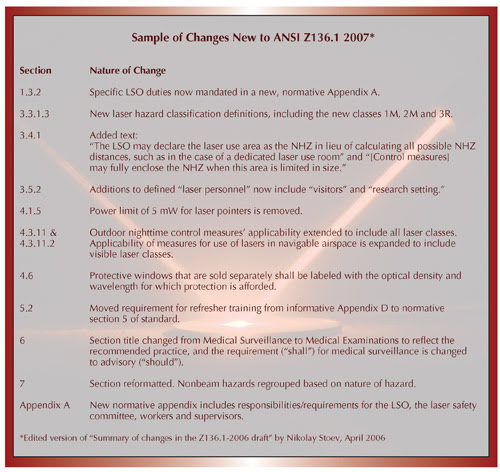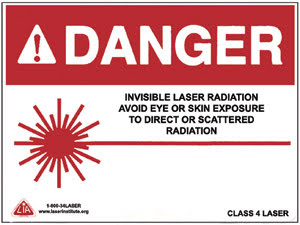Definitions and protocols are refined and simplified to improve safety, increase productivity and lower costs.
The Laser Institute of America
As a result of advances in laser devices and their applications both experimentally and in the field, the first update in seven years to the American National Standard for Safe Use of Lasers (ANSI Z136.1) has just been released. Because the standard is the foundation of laser safety programs for industrial, military, medical and educational applications nationwide, any revisions can and will affect the training and practice of laser safety in these environments.
The new standard (ANSI Z136.1 2007) provides an updated and thorough set of guidelines for implementing a safe laser program. A sampling of these changes (see table) includes a refined set of definitions, the expansion of laser classifications and new provisions for refresher training, safety protocols and changes in the medical surveillance requirements. Although many of these revisions are a consolidation of similar items into a more cohesive body, implementing some of them will require time and effort to ensure compliance with the new standard.

These are some specific changes to the standard, including the relevant sections and the substance of the change. This is only a sampling of the revisions to the standard. For further information, please refer to the full standard: ANSI Z136.1 2007.
One major change to the standard is the creation of two laser classifications (1M and 2M) and the conversion of Class 3A lasers to Class 3R, which harmonizes the ANSI standard with the classification scheme of the International Electrotechnical Commission (IEC 60825-1:2007). The laser Classes 1, 2, 3B and 4 remain unchanged, although there are some enhancements to the control measures, or safety protocols, especially as they apply to outdoor applications.
Previously, there were no requirements involving outdoor laser use except in regard to Class 3B and 4 lasers. Under the new standard, however, Classes 1M, 2, 2M and 3R used outdoors at night now have required control measures, including a nominal hazard zone (NHZ) analysis. Additionally, control measures for use of lasers in navigable airspace have been expanded to include all laser classes. For Class 3B and 4 lasers, there are also a few minor changes in the control measures for skin and window protection.
The significant reorganization of certain sections and a general consolidation of redundant material also have occurred. These changes make the document easier to implement and make it more consistent by reformatting the “Non-Beam Hazards” section based on the nature of the specific hazard.
 The 13 subdivisions under the Non-Beam Hazards heading are now only five: general, physical, chemical, biological agents and human factor. A comparison of the ANSI Z136.1 2000 standard and the new revision shows an effort to simplify the job of the laser safety officer (LSO) by organizing the potential nonbeam hazards while adding more depth to hazard identification.
The 13 subdivisions under the Non-Beam Hazards heading are now only five: general, physical, chemical, biological agents and human factor. A comparison of the ANSI Z136.1 2000 standard and the new revision shows an effort to simplify the job of the laser safety officer (LSO) by organizing the potential nonbeam hazards while adding more depth to hazard identification.
New definitions
As for the definitions in the new standard, many unnecessary entries were removed, and other terms or improved definitions have been added. For example calorimeter, cryogenics, tonometry and synergy no longer are part of the definitions list. Most of the terms removed were either in common usage or were specialized medical terms more useful in a different forum. On the other hand, some additions specific to the safe use of lasers afford a commonality of perspective needed to improve safety. An example of this is the addition of the terms “Condition 1” and “Condition 2.” They relate to the optically aided viewing of beams, and both terms increase comprehension of a described state. Another example is adding the term “laser personnel,” defined as, “Persons who routinely work around hazardous laser beams. This standard requires such persons to be protected by engineering controls, administrative procedures, or both.” Although this might have been assumed before, it is no longer left to conjecture.
Finally, there are several seemingly minor changes. For example, the “Medical Surveillance” section has been supplanted with a “Medical Examinations” section that is more relevant to common practices. There is also a new requirement for refresher training based on the “total hazard evaluation criteria” as codified in an earlier section, whereas in the previous standard, there was only a requirement that “training programs (shall be) required” with no provision for refresher training. Specific LSO duties are now combined into a new, mandated and normative appendix (Appendix A).
Yet these changes, when combined, form the basis for a higher degree of safety in the laser application arena. Some may add a bit more time or expense to the laser laboratory or factory floor, but others, such as adding a single line to the standard, can increase productivity and lower operating costs. For example, “The LSO may declare the laser use area as the NHZ in lieu of calculating all possible NHZ distances, such as in the case of a dedicated laser use room and [control measures] may fully enclose the NHZ when this area is limited in size.”
The new standard is now here, in part because of the continuing support of the Laser Institute of America. Fulfilling its mission of fostering lasers, laser applications and laser safety worldwide, the institute is the secretariat and publisher of the American National Standards Institute (ANSI) Z136 series of laser safety standards.
These documents provide a set of guidelines for implementing a safe laser program. The series is recognized by OSHA and is the authoritative series of laser safety documents in the US. LIA also offers to thousands of end users a wide array of products and services, including safety and applications publications, training videos, signs and labels, LSO training and conferences.
For additional information on the new ANSI Z136.1 standard, please visit www.laserinstitute.org or call +1-800-34LASER (+1-800-345-2737).
Meet the author
Stephen Lumbert wrote this on behalf of LIA. He resides in Orlando, Fla., and is a freelance technical writer and contributing editor for LIA Today.